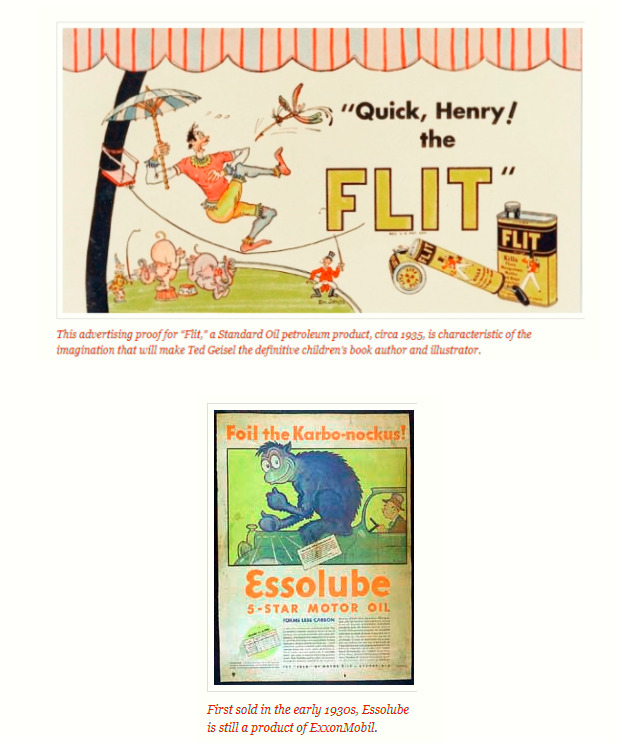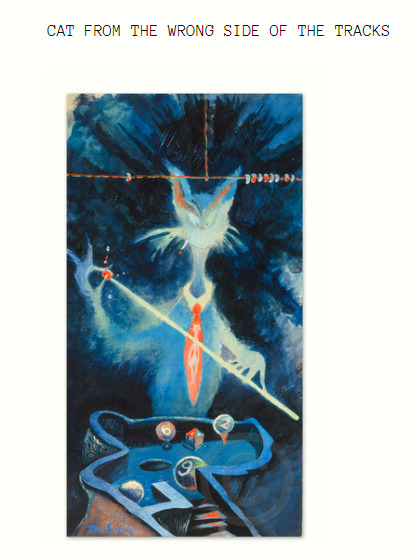Ted, Unraveled
A Book Review by Kimberly Gerry-Tucker
Memoirs are my favorite books to read, along with nonfiction, and also biology and neuroscience, and autobiography and biographies too. I read this one by Brian Jay Jones:

Like all of us, he started life as a baby, and then became a child. To be exact, he lived in Massachusetts on 74 Fairfield Street. Many decades later, after achieving a notoriety that surprised him, he revisited that child home. He told the current owner Ron Senez “I just stopped by to make sure you’re taking proper care of the house.” For some time he sat in Ron’s young sons’ room (Ted’s old bedroom as a child) and regaled them with stories. Ted showed them where he’d poked holes in the plaster and he told them a tantalizing story about a mural of “a lot of crazy animals” now covered by their wallpaper.
He started out drawing humorous cartoons for beer, oil companies, and the like, with a long-running very popular campaign for a bug company. (photos found at https://aoghs.org/petroleum-art/seuss-the-oilman/) His early work for these ad companies had many touches of the fanciful animals we would all come to know.


Of course… he eventually fell into children’s books. (I could’ve changed that line but I like the way it feels when considered literally!)
Suess’s wife was fond of saying that although Ted was witty, funny, somewhat introverted, and pleasant he was never happy when he was working on a book; but happiest when he finished one.
Writing the rhymes, he’d often fill in the last word as ‘duh-duh’ or ‘dum-dum’ and then he’d toss and turn on his couch in his office, read a nonfiction book or mystery to clear his mind, walk the beachfront property, scour thesauruses, and eventually replace the fill-in words with the rhymes. He kept a paper bullseye of his father’s hanging on his office wall, where his father had gotten the bullseye dead center, to remind him of perfection. He had the bullseye till his end of days. (Ted was a chain smoker and eventually a dentist found cancer under his tongue which spread. He did not like hospitals and often refused treatments that may have prolonged his life a bit.)|
When he first started, it was especially hard writing the Beginner Books series. There was a pedagogical rigor to the adherence of the approved word list. 361 approved beginning reader words to be exact. Authors were encouraged to have no more than 200 of the approved words per book.
No “ed”, “ing,” or “er” endings of words were allowed either, except if it was specifically listed.
Plurals were allowed but only if they were made by adding an “s.” Only approved contractions. No possessives. Finally the list was amended to allow “emergency” words, words not on the list but absolutely necessary to the story. Ted was quite a prankster and sometimes purposefully submitted x rated verse to Random House, and looked forward to the phone call that would surely follow! Truly, he would get a scolding, but he always left them laughing.
Example, an early “Hop on Pop” submission just to see if Stan was paying attention:
When I try to read, I am smart.
I always cut whole words apart.
Con Stan Tin O Ple, Tim Buk Too
Con Tra Cep Tive, Kan Ga Roo.
Or
This prank while working on “Dr. Seuss’ ABC:”
Big X
Little x
X…x…X
Someday, kiddies, you’ll learn about sex!
A more elaborate prank was played on a frequent house guest to the dinner parties at the Tower (he and his wife’s home in LaJolla). The man was always going on about how he collected fine abstract art. One day, Ted made up a fanciful long-syllabled-made-up “artist” name, worthy of his Suess books, and said that he had in his possession a rare abstract artwork by this big wig so and so “famous” artist.
The man replied “Oh! I have always wanted an art piece by that artist!” Dr. Suess said he’d be willing to sell. Not long afterward, Dr. Suess presented the man with a framed abstract artwork (paint barely dry) that he’d secretly, and quickly, created himself. The man oohed and ahed! Ted could keep a straight face easily. Just when the man was ready to hand Ted a very large sum of money, Ted’s wife stepped in and said the prank had gone on long enough! Laughs were had all around. I wonder where that art is today.
Dr. Suess (he dropped out before he earned a doctorate but was to go on and be awarded honorary ones) was serious about “brat books,” as he affectionately called them. He felt the Run Sally, Run! books were detrimental to children and insulted their intelligence along with being boring and not stimulating in children a desire to read. Though he never had children, (his first wife, who could not bear children, took her own life in the Tower, devastating Ted), he knew how to be in a child’s world and also how to create worlds for them to be in.
From his home in La Jolla California, where he lived in what was known as “The Tower,” he’d receive more and more mail as time went by. He’d even have children ring his doorbell often asking if he were really Dr. Suess, or to wish him a happy birthday, and then run away down the hill. At first he answered the fan mail but it got to be so much, that eventually most fan mail was answered with a copy of a signed form letter Ted had written and drawn on himself, thanking the letter writer and explaining Dr. Seuss’s mail delivery was slow because he lived on a mountaintop where mail could only be delivered by a Suessian beast called a Budget, pulling a cart driven by a Nudget. Imagine having a copy of one of those today!
He was a true storyteller, granting few interviews, and always showing up for events, especially early on, if there was an arranged deal that he would not have to speak in front of the crowd. About himself, he told and retold stories so much that often many accounts of the same story are different. It was part of his charm. The office at Random House, which he visited when he hand-delivered finished books to read them aloud, much to everyone’s delight, he had a hand in decorating to suit him! The office there was whimsical, as per his decorating instruction.
Ted was terrified of public speaking, but toward the end of his life, he managed to speak publicly in simple rhymes. They were short, to the point. For example, if asked to speak to college grad students, he’d step up to the podium, deliver four verses of rhyming advice, and amidst cheers he’d quickly leave the podium.
He didn’t preach, but his stories often were about big issues. Yertle the Turtle (who represents Hitler) was written in delightful anapestic tetrameter. It was banned in some areas for being ‘too political.’ Sneetches on Beaches was written in 1961 to teach children about discrimination. He wrote the book to address how different groups of people didn’t like each other during World War II. A number of the Seuss books address the subject of diversity and teach children to be fair and treat people equally. And there’s my favorite The Lorax. I don’t mean the silly movie adaptation, I mean his version, the book. Ted was a stickler on getting every single color in his books the way he wanted. He’d have loud conversations about this. And when a few stories were made into cartoons, he wanted them his way. It was his work. Not so sure he’d approve of the Grinch That Stole Christmas movie that takes liberties with his writing (sorry Jim Carrey.)
But who knows… Back to The Lorax which was written in 1971. It chronicles the plight of the environment and the Lorax “speaks for the trees” and confronts the Once-ler, who causes environmental degradation. At the end when the last tree stump remains, there is written upon it one word:

Truly if I get a tattoo one day it will be UNLESS. A word that speaks volumes.
He’s left a legacy. I can’t begin to recount the tidbits I learned from the book. I do know that somewhere in this house I’ve got an “adult” Dr. Suess book, full of his art meant for adults. No I can’t find the book, but I was able to locate a few of the art pieces from this site ( https://www.drseussart.com/secretandarchive ):



Kimberly Gerry Tuckeris an Art of Autism board member, artist, and author of Under The Banana Moon (living, loving, loss and aspergers/selective mutism).









I too love Dr Suess, and his wonderful made up words and creatures!